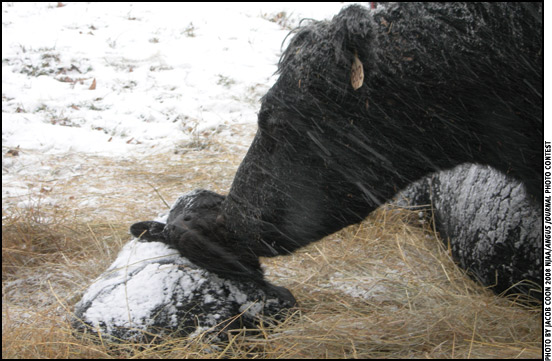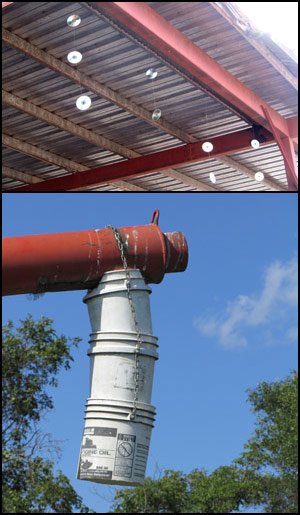MANAGEMENT...

Hypothermia and Thermogenesis
Overcoming hypothermia can be attributed to the process of body heat generation known as thermogenesis.
Why do some calves survive being born on a cold, wet, blustery night, while others exposed to the same conditions die of hypothermia? Most will agree that these calves have a lot of heart with a strong will to live. When these nub-eared, bobtailed survivors are brought to the branding fire, cowboys generally compliment the cow as a good mother. Much of the credit, however, can be attributed to the fascinating process of body heat generation known as thermogenesis. There are two types of thermogenesis: shivering and non-shivering. Read more in “Cow Camp Chatter.”

Grain Markets Encourage Forage Use
High grain prices warrant increased forage usage.
Intense short-term issues — namely drought and high corn prices — mean the beef industry must adjust production systems, and the markets are pointing to more forage usage, said Derrell Peel, Breedlove professor of agribusiness and livestock marketing specialist at Oklahoma State University (OSU). Peel set the stage for a forage seminar hosted in Nashville by Dow AgroSciences the day before the Cattle Industry Annual Convention and NCBA Trade Show kicked off.
Peel said forage usage will be instrumental in rising to meet the challenge of increased agricultural demand due to a rapidly growing global population because it allows for flexibility to maintain the beef industry's competitiveness. This flexibility, he said, can be one of beef's strongest suits.
"As an industry, we have one job to do, [produce beef], but we have lots of ways to do it," Peel said. Read more.
 On-Farm Tricks
On-Farm Tricks
Here are two clever, cost-effective solutions to day-to-day challenges on the farm or ranch.
A little fishing line and a few old compact discs (CDs) strung together serve as an effective — and low-cost — ornament to scare birds away. Hung vertically, with two or three CDs about 12 inches apart, the CDs twirl in the wind and their reflective coating gives off a bright glint to keep birds out of the feed shed. Line a rooftop with a half-dozen or more of the CD strands, and your bird problems should be solved.Five-gallon pails can be a quick and easy solution to help guide grain being augered into a bin. Cut the bottoms out of three pails, link them together with chain for the desired length and use a chain to secure them to the top of the auger. This clever creation can be especially useful when unloading grain on windy days.
Air Quality Tool Available to Livestock Producers
Voluntary air quality assessment can help producers forestall regulatory requirements.
Livestock producers can now make sure they are doing their best to minimize air emissions with a new self-assessment tool developed by a team of researchers and extension specialists from across the United States.
The tool was developed for use by livestock producers and their consultants to look at various management decisions and determine how those ultimately affect the air quality emissions from a particular site, said Brent Auvermann, a Texas AgriLife Extension Service agricultural engineer in Amarillo and member of the team. Read more.
Marketable Asset?
Wet fall and warm winter leave abundance of manure farmers can use as crop nutrient.
An unusually wet fall and unseasonably warm winter have left many livestock farmers exploring every option to find extra storage for manure. An Ohio State University (OSU) Extension researcher says farmers can utilize a portion of their manure to replace commercial fertilizer on wheat and corn crops, a practice that can also protect the environment.
While the use of manure as a fertilizer has long been appreciated by farmers, the time and high costs associated with transportation of manure, along with the convenience and application efficiency of synthetic fertilizers, has resulted in manure being applied during summer and fall months after crop harvest, he said. As fertilizer costs have risen sharply in recent years, more farmers may now be interested in applying manure to wheat and corn because the nutrients are in their manure storages waiting to be used, Arnold said. Read more.

Kris Ringwall
Beef Talk
Cattle size is different than cow size.
This discussion starts with a very popular topic, which is cattle size. One could say cow, bull or calf size. However, in reality, all cattle have a relevant body size and, like all species, the variation in size is huge. Not only the absolute size, but the shape of the body mass also is very variable. Bone, muscle and fat wrapped in hide make up the container that holds all the other assorted organs and essentials.
Remarkably, all living things need to be in biological balance within themselves, so one does not see a huge variance in how cattle are put together. In other words, large, medium and small types tend to have the same working parts and, for all practical considerations, in the same proportion as all members of the herd. That being said, the obvious constraints of larger or smaller cattle rest more with the management of the producer's system than the actual size of the cattle. Read more.
New Products
Industry affiliates provide a wide array of products and services to assist you on the farm and ranch. Here's an assortment of new products to hit the market recently.
- Pistol-grip syringe
- Hydraulic hitch
- Redesigned mixer
- Small wheel loaders
- Feed additive
- Manure spreader
Angus Advisor
Click here for February herd management tips from cattle experts across the nation. Advice separated by region.
[Click here to go to the top of the page.]










